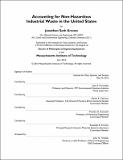| dc.contributor.advisor | John E. Fernández | en_US |
| dc.contributor.author | Krones, Jonathan Seth | en_US |
| dc.contributor.other | Massachusetts Institute of Technology. Engineering Systems Division. | en_US |
| dc.coverage.spatial | n-us--- | en_US |
| dc.date.accessioned | 2017-01-23T20:08:42Z | |
| dc.date.available | 2017-01-23T20:08:42Z | |
| dc.date.copyright | 2016 | en_US |
| dc.date.issued | 2016 | en_US |
| dc.identifier.uri | http://hdl.handle.net/1721.1/106591 | |
| dc.description | Thesis: Ph. D. in Engineering Systems, Massachusetts Institute of Technology, School of Engineering, Institute for Data, Systems, and Society, 2016. | en_US |
| dc.description | This electronic version was submitted by the student author. The certified thesis is available in the Institute Archives and Special Collections. | en_US |
| dc.description | Cataloged from student-submitted PDF version of thesis. | en_US |
| dc.description | Includes bibliographical references (pages 291-309). | en_US |
| dc.description.abstract | This dissertation presents a method for estimating the tonnage and composition of non-hazardous industrial waste (NHIW) flows in the United States. For thirty years, it has been an accepted fact that NHIW is generated at a rate of 6.9 billion Mg per year, making it the largest waste flow in the country by more than an order of magnitude. However, this value was generated in 1985, has not been updated since, and is thought to account largely for the weight of dilute process water disposed in surface impoundments rather than solid waste generated by industry. To address this data gap, and lacking the resources to collect new, national-scale information, I propose an approach by which three independent estimates of NHIW generation based on existing data are used to corroborate each other at the industry sector level. The individual estimates are compared in triangulation so as to control for the errors, uncertainties and other validity concerns unique to each. The methods are: forecasting from historical waste accounts, modeling industrial materials flows to calculate lost mass, and up-scaling state-level data reported to the Pennsylvania Residual Waste Program. I apply the triangulation method to three industrial sectors for the year 2010, yielding estimates of (all in million Mg) 9.7-14.9 from pulp and paper, 21.2-24.7 from iron and steel, and 0.96-1.24 from petroleum refining. These values suggest that the total quantity of NHIW is measured in the hundreds of millions of Mg, not the billions as claimed by the prevailing EPA account. It therefore appears that NHIW generation rates are comparable to those of municipal solid waste. Accurate waste accounting based on reliable, repeatable, and efficient methods is an important tool for characterizing current environmental challenges and understanding trends and the effects of key drivers. Waste accounts are also essential for developing and tracking progress on sustainability strategies like industrial symbiosis, in which wastes like NHIW are used as substitutes for raw materials throughout the economy. The method developed here satisfies these needs and answers what has been an open question for nearly three decades. | en_US |
| dc.description.statementofresponsibility | by Jonathan Seth Krones. | en_US |
| dc.format.extent | 309 pages | en_US |
| dc.language.iso | eng | en_US |
| dc.publisher | Massachusetts Institute of Technology | en_US |
| dc.rights | M.I.T. theses are protected by copyright. They may be viewed from this source for any purpose, but reproduction or distribution in any format is prohibited without written permission. See provided URL for inquiries about permission. | en_US |
| dc.rights.uri | http://dspace.mit.edu/handle/1721.1/7582 | en_US |
| dc.subject | Institute for Data, Systems, and Society. | en_US |
| dc.subject | Engineering Systems Division. | en_US |
| dc.title | Accounting for non-hazardous industrial waste in the United States | en_US |
| dc.title.alternative | Accounting for NHIW in the United States | en_US |
| dc.type | Thesis | en_US |
| dc.description.degree | Ph. D. in Engineering Systems | en_US |
| dc.contributor.department | Massachusetts Institute of Technology. Engineering Systems Division | |
| dc.contributor.department | Massachusetts Institute of Technology. Institute for Data, Systems, and Society | |
| dc.identifier.oclc | 963240167 | en_US |
